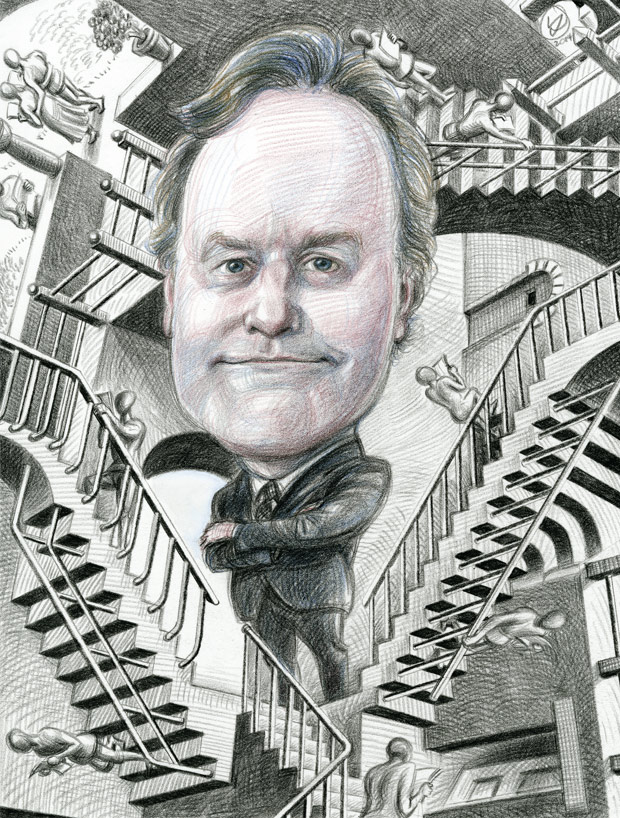Alan Brown Thinks Traditional De-Risking is Flawed
“First you have to decide on your end goal. We want a very low probability of the sponsor having to write any more checks and think that corresponds to a technical provisions funding ratio of around 125%. How do you get from where we are—105%—to 125%? Not just by ratcheting up your liability-driven investing [LDI] hedges to 100%. By doing so, you will have exposed yourself to a significant correlation risk, unless you’ve got nothing but bonds on the asset side of the balance sheet.
Viewing liabilities in isolation from assets can get you into trouble. Although the long-run correlation between equities and bonds is low, it masks significant periods of either high positive or high negative correlations. So the nightmare scenario, like during the taper in 2013, sees bonds in a spectacular bear market and long-term interest rates rising so quickly that equities and other risk assets are crushed at the same time.
 (Art by Victor Juhasz)
(Art by Victor Juhasz)
This gives positive correlation between equity and bond returns, and if you have fully hedged your liabilities, although discount rates would be rising, you would get no benefit because you’ve hedged it all away. At the same time, the asset side of your balance sheet is being crushed. You now have to go to the finance director after you’ve told him you’ve battened down the hatches and hedged everything away, and explain why the funding ratio is under pressure again.
Instead, you have to scale your bets and be agnostic towards your next step.
We are about 70% hedged to changes in real and nominal interest rates. That means a 1% move in interest rates, either up or down, impacts our funding ratio by about 4%. We’ve scaled our short duration position and know where we are. Many funds have no idea where they stand and will be much more exposed to changes in rates. The drop in yields we’ve just had (40 basis points) impacted our funding ratio by around 2%, but for many funds with much bigger short positions, the impact will be two to three times that.
Investors have become obsessed with market-cap-weighted benchmarks. For 30 years, people were saying, ‘Are you outperforming the gilt index?’ as interest rates went through a spectacular secular decline. The gilt market is way shorter in duration than most funds’ liabilities, but most portfolios were broadly matched to gilts and so were short duration. With a 30-year decline in interest rates, they took a massive hit. Following a “path-dependent process” is the right way to de-risk.
If our funding ratio recovers to 110% and continues up to 115%, and we start to think about taking more risk off the table, we will ask, ‘Why the improvement? Rising yields?’ In which case, it might make sense to increase the size of the hedges. Or did it improve because equities and other risk assets were on a tear? Then, the next step might be to reduce growth assets or change the makeup of them.
You don’t go in with a rigid, automatic plan which ratchets up the hedges every time the funding ratio hits a certain point. You have to ask the reason. In our last round of de-risking—in the fourth quarter of last year—we shifted half of our growth assets, which were entirely invested in a diversified growth strategy, to a bespoke, actively managed interest rate parity strategy. This improved the correlation between our assets and liabilities, and left us less exposed should we go through the kind of scenario we’ve been talking about.
When we reach another funding ratio target, I don’t know in advance what we’ll do, but this can only work because of the governance structure we have in place.
We have the financial director, consultant, lead investment manager, and trustees—all of whom have investment experience—together at the same time. We leave the unimportant decisions, such as which UK equity to buy, to the investment manager.
But the size and makeup of growth assets, and the size of the hedges against nominal and real interest rates, are collective decisions. If we’re on the wrong side of the argument, we don’t just fire the fund manager or consultant—it is a joint decision. We minute decisions in great detail, so if we find ourselves on the wrong side, we can look back at our assumptions—and whether they have proved to be incorrect. We then decide to move on or tough it out. That’s quite a different governance model.”
